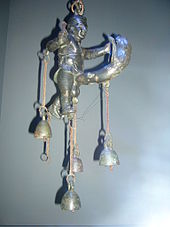Tintinnabulum (ancient Rome)


In ancient Rome, a tintinnabulum (less often tintinnum)[1] was a wind chime or assemblage of bells. A tintinnabulum often took the form of a bronze ithyphallic figure or of a fascinum, a magico-religious phallus thought to ward off the evil eye and bring good fortune and prosperity.
A tintinnabulum acted as a door amulet.[2][3] These were hung near thresholds[4] at a shop or house, under the peristyles (around the inner courtyard or garden) by the bedroom, or the venereum, where the wind would cause them to tinkle.[5][2] They were also made to ring like doorbells, a series of them being tied to cord attached to a bell pull.[6]
The sounds of bells were believed to keep away evil spirits; compare the apotropaic role of the bell in the "bell, book, and candle" ritual of the earlier Catholic Church.[2][7] It has also been surmised that oscilla hung on hooks along colonnaded porticoes may have comparable evil-warding intents.[8]
Hand-bells have been found in sanctuaries and other settings that indicate their religious usage, and were used at the Temple of Iuppiter Tonans, "Jupiter the Thunderer."[9] Elaborately decorated pendants for tintinnabula occur in Etruscan settings, depicting for example women carding wool, spinning, and weaving.[10] Bells were hung on the necks of domestic animals such as horses and sheep to keep track of the animals, but perhaps also for apotropaic purposes.[11]
A number of examples are part of the Secret Museum collection at the Museo Archeologico Nazionale di Napoli.[12]
See also
- Erotic art in Pompeii and Herculaneum
- Lucky charm (disambiguation)
- Mutunus Tutunus
- Priapus
- Sexuality in ancient Rome
References
- Citations
- ^ In the Latin of 6th-century Roman Gaul; J.N. Adams, The Regional Diversification of Latin, 200 BC–AD 600 (Cambridge University Press, 2007), p. 321.
- ^ ISBN 978-0-415-92567-9
- ISBN 9781134693146
- JSTOR 20167679
- ^ Fanin (1871), p. 58.
- ISBN 978-0-892-36164-9
- ^ "Bronze phallic wind chime (tintinabulum)". Highlights from the British Museum. Archived from the original on 2015-10-18. Retrieved 2017-06-15.
- ^ Taylor (2005), pp. 83, 95
- ^ Duncan Fishwick, Imperial Cult in the Latin West (Brill, 1990), vol. II.1, pp. 504-5.
- ^ Larissa Bonfante, Etruscan Life and Afterlife: A Handbook of Etruscan Studies (Wayne State University Press, 1986), p. 252.
- ^ Adams, Regional Diversification, p. 321.
- ^ Fanin (1871), pp. 58ff
- Sources
- Colonel Fanin (pseud. of César Famin) [in French] (1871). "Votive Phalli". The Royal Museum at Naples. Being Some Account of the Erotic Paintings, Bronzes, and Statues Contained in that Famous "Cabinet Secret". Chez David. pp. 58–.
Further reading
- Sex or symbol: erotic images of Greece and Rome by ISBN 0-7141-8042-4
- Eros in Pompeii: the erotic art collection of the Museum of Naples by Michael Grant, Antonia Mulas, Museo nazionale di Napoli (1997)
- The Roman cultural revolution by Thomas N. Habinek, Alessandro Schiesaro (1997) p. 171
External links
- Highlights from the British Museum: Lion-phallus, winged phallus, diphallic figure
- Metropolitan Museum of Art: Bronze phallic ornament
